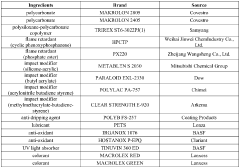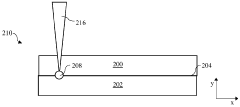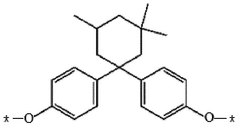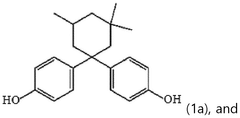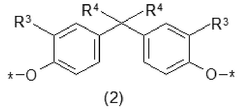Polycarbonate Contributions to Automotive Light Weighting
JUL 1, 20259 MIN READ
Generate Your Research Report Instantly with AI Agent
Patsnap Eureka helps you evaluate technical feasibility & market potential.
Polycarbonate Automotive Evolution
The evolution of polycarbonate in automotive applications has been a significant driver in the industry's pursuit of lightweight solutions. Initially introduced in the 1960s for non-structural components, polycarbonate has steadily expanded its role in vehicle design and manufacturing over the past six decades.
In the early stages, polycarbonate was primarily used for interior components such as instrument panels and small exterior parts like light covers. Its lightweight properties and impact resistance made it an attractive alternative to traditional materials, but limitations in weatherability and scratch resistance restricted its broader adoption.
The 1980s and 1990s saw a surge in polycarbonate usage as advancements in coating technologies addressed many of its shortcomings. This period marked the beginning of polycarbonate's application in larger exterior components, including headlamp lenses and side windows. The material's ability to be molded into complex shapes also opened new design possibilities for automakers.
By the turn of the millennium, polycarbonate had become an integral part of automotive light weighting strategies. Its use expanded to include panoramic roofs, rear windows, and even body panels in some concept vehicles. The material's excellent thermal insulation properties also contributed to improved energy efficiency in vehicle climate control systems.
Recent years have witnessed a dramatic increase in polycarbonate's structural applications. Advanced grades of the material, often reinforced with glass fibers or blended with other polymers, are now being used in semi-structural and structural components. This shift has been driven by the automotive industry's push towards electric vehicles, where weight reduction is crucial for extending range and improving performance.
The latest developments in polycarbonate technology focus on enhancing its recyclability and incorporating bio-based content, aligning with the industry's sustainability goals. These innovations are paving the way for even broader adoption of polycarbonate in future vehicle designs, potentially replacing traditional materials in more critical structural elements.
As we look towards the future, the evolution of polycarbonate in automotive applications is likely to continue at an accelerated pace. With ongoing research into new formulations and processing techniques, polycarbonate is poised to play an even more significant role in achieving the lightweight, efficient, and sustainable vehicles of tomorrow.
In the early stages, polycarbonate was primarily used for interior components such as instrument panels and small exterior parts like light covers. Its lightweight properties and impact resistance made it an attractive alternative to traditional materials, but limitations in weatherability and scratch resistance restricted its broader adoption.
The 1980s and 1990s saw a surge in polycarbonate usage as advancements in coating technologies addressed many of its shortcomings. This period marked the beginning of polycarbonate's application in larger exterior components, including headlamp lenses and side windows. The material's ability to be molded into complex shapes also opened new design possibilities for automakers.
By the turn of the millennium, polycarbonate had become an integral part of automotive light weighting strategies. Its use expanded to include panoramic roofs, rear windows, and even body panels in some concept vehicles. The material's excellent thermal insulation properties also contributed to improved energy efficiency in vehicle climate control systems.
Recent years have witnessed a dramatic increase in polycarbonate's structural applications. Advanced grades of the material, often reinforced with glass fibers or blended with other polymers, are now being used in semi-structural and structural components. This shift has been driven by the automotive industry's push towards electric vehicles, where weight reduction is crucial for extending range and improving performance.
The latest developments in polycarbonate technology focus on enhancing its recyclability and incorporating bio-based content, aligning with the industry's sustainability goals. These innovations are paving the way for even broader adoption of polycarbonate in future vehicle designs, potentially replacing traditional materials in more critical structural elements.
As we look towards the future, the evolution of polycarbonate in automotive applications is likely to continue at an accelerated pace. With ongoing research into new formulations and processing techniques, polycarbonate is poised to play an even more significant role in achieving the lightweight, efficient, and sustainable vehicles of tomorrow.
Lightweight Vehicle Market Trends
The automotive industry is experiencing a significant shift towards lightweight vehicles, driven by stringent fuel efficiency regulations and the growing demand for electric vehicles. This trend has led to a surge in the lightweight vehicle market, which is expected to continue its robust growth in the coming years. The market is primarily fueled by the need to reduce vehicle weight to improve fuel economy, enhance performance, and extend the range of electric vehicles.
In recent years, the lightweight vehicle market has seen substantial growth across various regions. North America and Europe have been at the forefront of this trend, with automakers in these regions actively incorporating lightweight materials into their vehicle designs. The Asia-Pacific region, particularly China and Japan, is also witnessing rapid adoption of lightweight technologies in automotive manufacturing.
The market is characterized by the increasing use of advanced materials such as high-strength steel, aluminum, magnesium, and composites, including polycarbonate. These materials offer significant weight reduction potential while maintaining or even improving vehicle safety and performance. Polycarbonate, in particular, has gained traction due to its unique combination of properties, including high impact resistance, optical clarity, and design flexibility.
The lightweight vehicle market is not limited to passenger cars but extends to commercial vehicles as well. Light commercial vehicles and trucks are increasingly adopting lightweight materials to improve payload capacity and fuel efficiency. This expansion across vehicle segments is contributing to the overall market growth.
Technology advancements in manufacturing processes have played a crucial role in driving the lightweight vehicle market. Innovations in joining technologies, such as adhesive bonding and advanced welding techniques, have enabled the integration of diverse materials in vehicle structures. Additionally, advancements in computer-aided engineering and simulation tools have allowed automakers to optimize vehicle designs for weight reduction without compromising structural integrity.
The market is also influenced by changing consumer preferences and increasing environmental awareness. Consumers are increasingly valuing fuel efficiency and environmental sustainability in their vehicle purchasing decisions, which aligns with the benefits offered by lightweight vehicles. This shift in consumer behavior is encouraging automakers to invest more in lightweight technologies and materials.
Looking ahead, the lightweight vehicle market is poised for continued growth, driven by ongoing technological advancements, regulatory pressures, and the accelerating transition to electric vehicles. The integration of lightweight materials, including polycarbonate, is expected to play a crucial role in shaping the future of automotive design and manufacturing, contributing to more efficient and sustainable transportation solutions.
In recent years, the lightweight vehicle market has seen substantial growth across various regions. North America and Europe have been at the forefront of this trend, with automakers in these regions actively incorporating lightweight materials into their vehicle designs. The Asia-Pacific region, particularly China and Japan, is also witnessing rapid adoption of lightweight technologies in automotive manufacturing.
The market is characterized by the increasing use of advanced materials such as high-strength steel, aluminum, magnesium, and composites, including polycarbonate. These materials offer significant weight reduction potential while maintaining or even improving vehicle safety and performance. Polycarbonate, in particular, has gained traction due to its unique combination of properties, including high impact resistance, optical clarity, and design flexibility.
The lightweight vehicle market is not limited to passenger cars but extends to commercial vehicles as well. Light commercial vehicles and trucks are increasingly adopting lightweight materials to improve payload capacity and fuel efficiency. This expansion across vehicle segments is contributing to the overall market growth.
Technology advancements in manufacturing processes have played a crucial role in driving the lightweight vehicle market. Innovations in joining technologies, such as adhesive bonding and advanced welding techniques, have enabled the integration of diverse materials in vehicle structures. Additionally, advancements in computer-aided engineering and simulation tools have allowed automakers to optimize vehicle designs for weight reduction without compromising structural integrity.
The market is also influenced by changing consumer preferences and increasing environmental awareness. Consumers are increasingly valuing fuel efficiency and environmental sustainability in their vehicle purchasing decisions, which aligns with the benefits offered by lightweight vehicles. This shift in consumer behavior is encouraging automakers to invest more in lightweight technologies and materials.
Looking ahead, the lightweight vehicle market is poised for continued growth, driven by ongoing technological advancements, regulatory pressures, and the accelerating transition to electric vehicles. The integration of lightweight materials, including polycarbonate, is expected to play a crucial role in shaping the future of automotive design and manufacturing, contributing to more efficient and sustainable transportation solutions.
Polycarbonate Tech Challenges
The integration of polycarbonate materials in automotive light weighting faces several significant technical challenges. One of the primary obstacles is achieving the necessary strength and durability to meet safety standards while maintaining the lightweight properties that make polycarbonate attractive. This requires advanced engineering to optimize the material's molecular structure and additives to enhance impact resistance and structural integrity.
Another challenge lies in the thermal management of polycarbonate components. The material's relatively low heat resistance compared to traditional metals can lead to deformation or degradation under extreme temperature conditions, particularly in areas close to the engine or exhaust system. Developing heat-resistant grades of polycarbonate or implementing effective thermal insulation strategies is crucial to overcome this limitation.
Surface quality and weatherability present additional hurdles. Polycarbonate is susceptible to scratching and can yellow or become brittle when exposed to UV radiation over time. Addressing these issues necessitates the development of advanced coatings or the incorporation of UV stabilizers without compromising the material's transparency or mechanical properties.
The bonding and joining of polycarbonate parts to other materials in the vehicle structure pose significant technical difficulties. Traditional welding techniques used for metals are not applicable, and adhesive bonding must be carefully engineered to ensure long-term durability and resistance to environmental factors such as moisture and temperature fluctuations.
Manufacturing processes for large-scale polycarbonate automotive components also present challenges. Injection molding of large, complex parts requires precise control of processing parameters to avoid defects such as warpage, sink marks, and internal stresses. Additionally, achieving consistent quality across high-volume production runs demands sophisticated mold design and process optimization.
Recycling and end-of-life considerations for polycarbonate automotive parts are becoming increasingly important. Developing efficient methods for separating polycarbonate from multi-material assemblies and establishing effective recycling processes that maintain material properties are ongoing challenges that need to be addressed to improve the overall sustainability of polycarbonate use in automotive applications.
Lastly, the cost-effectiveness of polycarbonate solutions compared to traditional materials remains a significant hurdle. While polycarbonate offers weight savings, the higher material cost and potentially more complex manufacturing processes can offset some of the benefits. Ongoing research and development efforts are focused on reducing production costs and improving the overall value proposition of polycarbonate in automotive light weighting applications.
Another challenge lies in the thermal management of polycarbonate components. The material's relatively low heat resistance compared to traditional metals can lead to deformation or degradation under extreme temperature conditions, particularly in areas close to the engine or exhaust system. Developing heat-resistant grades of polycarbonate or implementing effective thermal insulation strategies is crucial to overcome this limitation.
Surface quality and weatherability present additional hurdles. Polycarbonate is susceptible to scratching and can yellow or become brittle when exposed to UV radiation over time. Addressing these issues necessitates the development of advanced coatings or the incorporation of UV stabilizers without compromising the material's transparency or mechanical properties.
The bonding and joining of polycarbonate parts to other materials in the vehicle structure pose significant technical difficulties. Traditional welding techniques used for metals are not applicable, and adhesive bonding must be carefully engineered to ensure long-term durability and resistance to environmental factors such as moisture and temperature fluctuations.
Manufacturing processes for large-scale polycarbonate automotive components also present challenges. Injection molding of large, complex parts requires precise control of processing parameters to avoid defects such as warpage, sink marks, and internal stresses. Additionally, achieving consistent quality across high-volume production runs demands sophisticated mold design and process optimization.
Recycling and end-of-life considerations for polycarbonate automotive parts are becoming increasingly important. Developing efficient methods for separating polycarbonate from multi-material assemblies and establishing effective recycling processes that maintain material properties are ongoing challenges that need to be addressed to improve the overall sustainability of polycarbonate use in automotive applications.
Lastly, the cost-effectiveness of polycarbonate solutions compared to traditional materials remains a significant hurdle. While polycarbonate offers weight savings, the higher material cost and potentially more complex manufacturing processes can offset some of the benefits. Ongoing research and development efforts are focused on reducing production costs and improving the overall value proposition of polycarbonate in automotive light weighting applications.
Current Polycarbonate Solutions
01 Molecular weight control of polycarbonates
Various methods are employed to control the molecular weight of polycarbonates during synthesis. These include adjusting reaction conditions, using specific catalysts, and adding chain terminators. Controlling molecular weight is crucial for achieving desired physical properties and processability of polycarbonate resins.- Molecular weight control of polycarbonates: Various methods are employed to control the molecular weight of polycarbonates during synthesis. These techniques may involve adjusting reaction conditions, using specific catalysts, or adding chain terminators to achieve desired molecular weights. Controlling molecular weight is crucial for tailoring the properties of polycarbonates for specific applications.
- Light-weight polycarbonate compositions: Development of light-weight polycarbonate compositions involves incorporating additives or modifying the polymer structure to reduce overall density while maintaining desirable mechanical properties. These formulations are particularly useful in applications where weight reduction is critical, such as automotive and aerospace industries.
- High molecular weight polycarbonates: Synthesis of high molecular weight polycarbonates is achieved through optimized polymerization processes. These materials often exhibit enhanced mechanical strength, thermal stability, and impact resistance compared to their lower molecular weight counterparts. Applications include durable goods and high-performance engineering plastics.
- Weight reduction in polycarbonate blends: Polycarbonate blends are formulated to achieve weight reduction while maintaining or improving specific properties. This may involve blending polycarbonates with other polymers or incorporating fillers and additives to optimize the balance between weight and performance characteristics.
- Polycarbonate weight measurement techniques: Various analytical techniques are employed to accurately measure the weight and molecular weight distribution of polycarbonates. These methods may include gel permeation chromatography, light scattering, and viscometry. Precise weight measurement is essential for quality control and ensuring consistent material properties in polycarbonate production.
02 Light-weight polycarbonate compositions
Development of light-weight polycarbonate compositions involves incorporating additives or modifying the polymer structure. These formulations aim to reduce the overall weight of polycarbonate products while maintaining their mechanical properties, making them suitable for applications where weight reduction is critical.Expand Specific Solutions03 High molecular weight polycarbonates
Synthesis of high molecular weight polycarbonates is achieved through optimized polymerization processes. These materials offer enhanced mechanical properties, improved heat resistance, and better chemical stability compared to their lower molecular weight counterparts, making them suitable for demanding applications.Expand Specific Solutions04 Weight reduction in polycarbonate blends
Polycarbonate blends are developed to achieve weight reduction while maintaining or improving specific properties. These blends often incorporate other polymers or additives to create synergistic effects, resulting in materials with optimized weight-to-performance ratios for various applications.Expand Specific Solutions05 Polycarbonate weight measurement techniques
Various techniques are employed to accurately measure the weight and molecular weight distribution of polycarbonates. These methods include gel permeation chromatography, light scattering, and viscometry. Precise weight measurement is essential for quality control and ensuring consistent performance of polycarbonate materials.Expand Specific Solutions
Key Polycarbonate Manufacturers
The automotive light weighting market, driven by polycarbonate contributions, is in a growth phase with increasing market size and technological advancements. The competitive landscape is characterized by major players like Covestro Deutschland AG, SABIC Global Technologies BV, and LG Chem Ltd., who are investing heavily in R&D to develop innovative polycarbonate solutions. These companies, along with others such as Teijin Ltd. and Kingfa Sci. & Tech. Co., Ltd., are focusing on enhancing the performance and sustainability of polycarbonate materials for automotive applications. The technology's maturity is progressing rapidly, with companies like Bayer AG and Idemitsu Kosan Co., Ltd. pushing the boundaries of polycarbonate's capabilities in light weighting solutions.
Covestro Deutschland AG
Technical Solution: Covestro has developed high-performance polycarbonate blends specifically for automotive light weighting. Their Makrolon® AI series offers up to 50% weight reduction compared to steel[1]. These materials feature high impact strength, dimensional stability, and thermal resistance. Covestro's continuous fiber-reinforced thermoplastic composites (CFRTP) combine polycarbonate with carbon or glass fibers, achieving strength-to-weight ratios comparable to metals[2]. They've also introduced Makrolon® Ai, a polycarbonate grade with improved flow properties, enabling the production of large, thin-walled components for automotive applications[3].
Strengths: Extensive experience in polycarbonate production, strong R&D capabilities, and a wide range of tailored solutions. Weaknesses: Higher cost compared to traditional materials, potential limitations in extreme temperature applications.
SABIC Global Technologies BV
Technical Solution: SABIC has pioneered the development of LEXAN™ polycarbonate resins for automotive light weighting. Their LEXAN™ HF series offers high flow properties, allowing for thinner wall designs and up to 40% weight savings in large automotive parts[4]. SABIC's LEXAN™ EXL copolymers provide enhanced low-temperature ductility and improved impact resistance, crucial for safety-critical components. The company has also introduced LEXAN™ GTX, a polycarbonate-polybutylene terephthalate (PC-PBT) blend, offering excellent chemical resistance and weatherability for exterior applications[5]. SABIC's continuous fiber reinforced thermoplastic composites (CFRTC) combine LEXAN™ resin with carbon fiber, achieving strength comparable to metals at significantly lower weights[6].
Strengths: Broad portfolio of specialized polycarbonate grades, strong global presence, and extensive automotive industry partnerships. Weaknesses: Potential challenges in recycling complex blends, higher material costs compared to conventional plastics.
Innovative Polycarbonate Patents
Polycarbonate-based compositions and laser-welded articles including same
PatentWO2024055232A1
Innovation
- Optimized composition of polycarbonate-based material with specific weight percentages of components to achieve desired properties for laser welding.
- Balanced combination of polycarbonate and polysiloxane-polycarbonate copolymer to achieve thin-wall flame retardancy, melt flow rate, and low temperature impact strength.
- Incorporation of impact modifier in a specific range to improve low temperature impact strength without significantly affecting other properties.
Polycarbonate composition
PatentWO2024141296A1
Innovation
- A polycarbonate composition comprising copolycarbonate with bis(4-hydroxyphenyl)-3,3,5-trimethylcyclohexane units, aromatic linear homopolycarbonate, poly(1,4-cyclohexylenedimethylene 1,4-cyclohexanedicarboxylate), and methyl methacrylate-n-butyl acrylate-butadiene-styrene copolymer, optimized to achieve a content relationship index that results in high light transmittance, low haze, and low birefringence.
Environmental Impact Assessment
The environmental impact assessment of polycarbonate contributions to automotive light weighting reveals both positive and negative aspects. On the positive side, the use of polycarbonate in automotive applications significantly reduces vehicle weight, leading to improved fuel efficiency and reduced greenhouse gas emissions during the vehicle's operational lifetime. Studies have shown that for every 10% reduction in vehicle weight, fuel consumption decreases by approximately 5-7%. This translates to substantial CO2 emission reductions over the vehicle's lifespan.
Furthermore, polycarbonate's durability and resistance to weathering contribute to extended product lifecycles, potentially reducing the need for frequent replacements and the associated environmental impacts of manufacturing new parts. The material's recyclability also presents opportunities for closed-loop systems, where end-of-life polycarbonate components can be reprocessed into new automotive parts or other products, minimizing waste and resource consumption.
However, the environmental impact of polycarbonate production must be considered. The manufacturing process is energy-intensive and involves the use of fossil fuel-derived raw materials. The production of bisphenol A (BPA), a key component in polycarbonate synthesis, has been associated with potential environmental and health concerns. Additionally, the use of additives and coatings to enhance polycarbonate's performance in automotive applications may complicate recycling processes and introduce potential contaminants into the environment.
The end-of-life management of polycarbonate automotive components presents both challenges and opportunities. While theoretically recyclable, the mixed material composition of many automotive parts can make separation and recycling difficult in practice. Improper disposal or incineration of polycarbonate can release harmful substances into the environment.
When comparing polycarbonate to alternative materials like glass or metal, a comprehensive life cycle assessment is necessary. While polycarbonate may offer weight savings and associated emissions reductions during the use phase, the environmental impacts of its production and end-of-life management must be weighed against those of alternative materials. Factors such as raw material sourcing, energy consumption during production, transportation emissions, and recyclability all play crucial roles in determining the overall environmental footprint.
In conclusion, while polycarbonate offers significant potential for reducing environmental impact through automotive light weighting, a holistic approach considering the entire life cycle is essential for accurate environmental impact assessment. Future research and development efforts should focus on improving the sustainability of polycarbonate production processes, enhancing recyclability, and developing more environmentally friendly additives to maximize the material's positive contributions to automotive sustainability.
Furthermore, polycarbonate's durability and resistance to weathering contribute to extended product lifecycles, potentially reducing the need for frequent replacements and the associated environmental impacts of manufacturing new parts. The material's recyclability also presents opportunities for closed-loop systems, where end-of-life polycarbonate components can be reprocessed into new automotive parts or other products, minimizing waste and resource consumption.
However, the environmental impact of polycarbonate production must be considered. The manufacturing process is energy-intensive and involves the use of fossil fuel-derived raw materials. The production of bisphenol A (BPA), a key component in polycarbonate synthesis, has been associated with potential environmental and health concerns. Additionally, the use of additives and coatings to enhance polycarbonate's performance in automotive applications may complicate recycling processes and introduce potential contaminants into the environment.
The end-of-life management of polycarbonate automotive components presents both challenges and opportunities. While theoretically recyclable, the mixed material composition of many automotive parts can make separation and recycling difficult in practice. Improper disposal or incineration of polycarbonate can release harmful substances into the environment.
When comparing polycarbonate to alternative materials like glass or metal, a comprehensive life cycle assessment is necessary. While polycarbonate may offer weight savings and associated emissions reductions during the use phase, the environmental impacts of its production and end-of-life management must be weighed against those of alternative materials. Factors such as raw material sourcing, energy consumption during production, transportation emissions, and recyclability all play crucial roles in determining the overall environmental footprint.
In conclusion, while polycarbonate offers significant potential for reducing environmental impact through automotive light weighting, a holistic approach considering the entire life cycle is essential for accurate environmental impact assessment. Future research and development efforts should focus on improving the sustainability of polycarbonate production processes, enhancing recyclability, and developing more environmentally friendly additives to maximize the material's positive contributions to automotive sustainability.
Safety Regulations Compliance
Polycarbonate's contribution to automotive light weighting must comply with stringent safety regulations to ensure vehicle occupant protection. The material's use in automotive applications is subject to various national and international safety standards, including Federal Motor Vehicle Safety Standards (FMVSS) in the United States and United Nations Economic Commission for Europe (UNECE) regulations globally.
One of the primary safety considerations for polycarbonate in automotive applications is its impact resistance. FMVSS 205 and UNECE Regulation No. 43 govern the use of glazing materials in vehicles, including polycarbonate. These regulations specify requirements for optical quality, durability, and impact resistance. Polycarbonate must demonstrate compliance with these standards through rigorous testing procedures, such as the ball drop test and the headform impact test.
In terms of fire safety, polycarbonate components must meet flammability requirements outlined in FMVSS 302 and its international counterpart, ISO 3795. These standards specify the maximum burn rate for materials used in vehicle interiors. Polycarbonate manufacturers have developed flame-retardant grades that comply with these regulations while maintaining the material's lightweight properties.
For structural applications, such as bumper systems and body panels, polycarbonate must meet crash performance standards. FMVSS 208 and UNECE Regulation No. 94 outline occupant protection requirements in frontal collisions. Polycarbonate components must contribute to the overall energy absorption and structural integrity of the vehicle during impact events.
Weathering resistance is another critical aspect of safety compliance for polycarbonate in automotive applications. FMVSS 108 and UNECE Regulation No. 48 specify requirements for lighting and signaling devices. Polycarbonate used in headlamps and taillights must maintain optical clarity and mechanical properties over the vehicle's lifetime, withstanding exposure to UV radiation, temperature fluctuations, and chemical agents.
To ensure long-term compliance with safety regulations, polycarbonate manufacturers work closely with automotive OEMs and tier suppliers to develop grades that meet specific performance requirements. This collaboration often involves extensive testing and validation processes, including accelerated weathering tests, impact simulations, and full-scale crash testing.
As vehicle electrification advances, new safety regulations are emerging that impact polycarbonate usage. For instance, UNECE Regulation No. 100 addresses the safety of electric power trains, including requirements for electrical insulation and protection against electric shock. Polycarbonate's excellent electrical insulation properties make it a suitable material for components in high-voltage systems, provided it meets the necessary safety standards.
One of the primary safety considerations for polycarbonate in automotive applications is its impact resistance. FMVSS 205 and UNECE Regulation No. 43 govern the use of glazing materials in vehicles, including polycarbonate. These regulations specify requirements for optical quality, durability, and impact resistance. Polycarbonate must demonstrate compliance with these standards through rigorous testing procedures, such as the ball drop test and the headform impact test.
In terms of fire safety, polycarbonate components must meet flammability requirements outlined in FMVSS 302 and its international counterpart, ISO 3795. These standards specify the maximum burn rate for materials used in vehicle interiors. Polycarbonate manufacturers have developed flame-retardant grades that comply with these regulations while maintaining the material's lightweight properties.
For structural applications, such as bumper systems and body panels, polycarbonate must meet crash performance standards. FMVSS 208 and UNECE Regulation No. 94 outline occupant protection requirements in frontal collisions. Polycarbonate components must contribute to the overall energy absorption and structural integrity of the vehicle during impact events.
Weathering resistance is another critical aspect of safety compliance for polycarbonate in automotive applications. FMVSS 108 and UNECE Regulation No. 48 specify requirements for lighting and signaling devices. Polycarbonate used in headlamps and taillights must maintain optical clarity and mechanical properties over the vehicle's lifetime, withstanding exposure to UV radiation, temperature fluctuations, and chemical agents.
To ensure long-term compliance with safety regulations, polycarbonate manufacturers work closely with automotive OEMs and tier suppliers to develop grades that meet specific performance requirements. This collaboration often involves extensive testing and validation processes, including accelerated weathering tests, impact simulations, and full-scale crash testing.
As vehicle electrification advances, new safety regulations are emerging that impact polycarbonate usage. For instance, UNECE Regulation No. 100 addresses the safety of electric power trains, including requirements for electrical insulation and protection against electric shock. Polycarbonate's excellent electrical insulation properties make it a suitable material for components in high-voltage systems, provided it meets the necessary safety standards.
Unlock deeper insights with Patsnap Eureka Quick Research — get a full tech report to explore trends and direct your research. Try now!
Generate Your Research Report Instantly with AI Agent
Supercharge your innovation with Patsnap Eureka AI Agent Platform!
